Outplay Alternatives
A detailed comparison of 10 Outplay alternatives. This guide analyzes each tool's features, pricing, and suitability for different sales teams.

You might be using Outplay for good reasons. As a sales engagement tool, it's often praised for its ease of use and CRM integrations. It performs well for core tasks like email sequencing, which is why many teams rely on it.
But like any tool, it has limits. Some users mention occasional integration issues or missing features. This might lead you to look for alternatives. We've analyzed top options based on G2 reviews to help you find the best fit for your team. Let's get started.
Consider 11x for Sales Automation
Before the main review, consider 11x. This platform provides autonomous agents if your team wants to use digital workers for sales tasks. These agents can handle parts of your sales process, offering a different approach to automation.
At 11x, we provide a GTM platform where AI agents autonomously manage your sales process. Our agent Alice finds high-intent prospects, runs outreach via email and LinkedIn, and keeps your CRM updated. A second agent, Julian, qualifies inbound leads and books meetings. We replace separate tools for data enrichment, outreach, and email warmup by unifying them in one platform.
Outplay Alternatives
The following section provides a detailed look at several Outplay alternatives. Each review examines pricing, core features, and the specific pros and cons when measured against Outplay.
1) Outreach
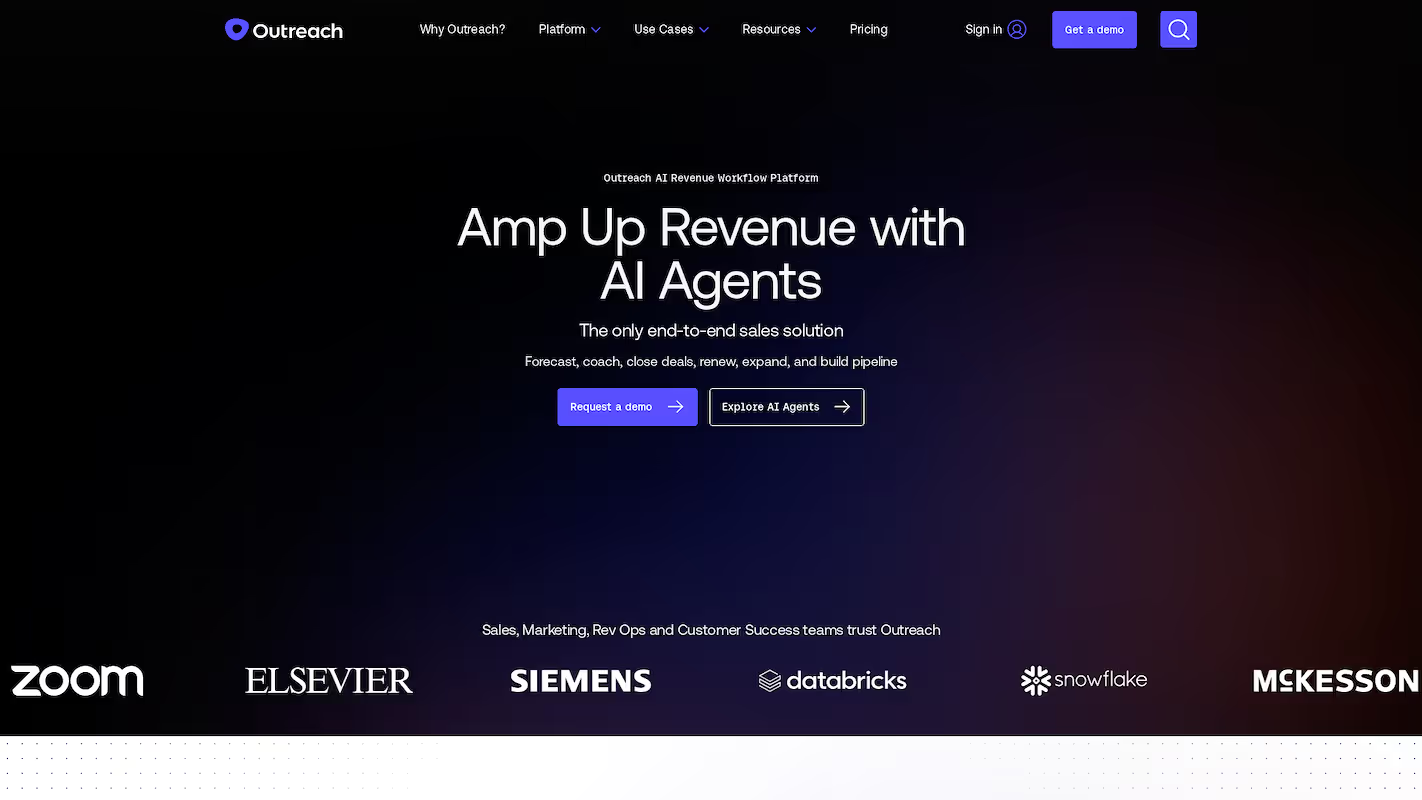
Outreach is a sales execution platform that uses AI agents and data-driven workflows. It supports the full revenue cycle, from pipeline creation to customer retention. The platform emphasizes security and governance for customer data.
Its functions include revenue forecasts and deal management with AI insights. Teams also use it to organize outbound campaigns and for automated analysis to support sales reps.
Outreach's Main Features
- Provides AI-driven rep coaching through meeting summaries, Q&A, and analytics via Kaia.
- Analyzes buyer sentiment by detecting topics across meetings, calls, and emails.
- Offers real-time content guidance with live meeting prompts and enablement content cards.
- Surfaces risks, next steps, and recent activity on any account or deal with Smart Assist.
How Outreach Compares to Outplay
Average Review score: 4.3/5 stars based on 3,479 G2 reviews.
- Outreach provides AI-powered sales coaching and conversation analysis, offering deeper insights into rep performance compared to Outplay.
- It unifies sales engagement with revenue intelligence in one platform, whereas Outplay often needs other tools for similar broad functionality.
- The platform's AI assists with revenue forecasting, a feature that gives more predictive power than Outplay's standard analytics.
- Unlike Outplay's focus on engagement, Outreach supports the full sales cycle, from finding leads to customer retention.
Where Outplay Has an Edge Over Outreach
- Outreach often comes with a higher price and a more involved setup. For teams that need a quick and budget-friendly start, Outplay might be a more straightforward choice.
- The platform's comprehensive nature can introduce a steeper learning curve. In contrast, Outplay is frequently noted for its user-friendly interface that allows for faster team adoption.
- Some users report occasional sync issues between Outreach and their CRM. This might cause data inconsistencies, a problem that can be less frequent with Outplay's more focused integration set.
Pricing and Budget Considerations
Based on user reviews, an Outplay license can be around $99 per month, offering a degree of price transparency. Outreach does not list its prices publicly, a common practice for enterprise-focused platforms that provide custom quotes based on specific needs.
2) Salesloft
Salesloft is a sales engagement platform used to manage customer interactions. It helps teams execute their sales plays, communicate with buyers, and get coaching insights. The platform combines engagement with revenue intelligence functions to cover the full sales cycle.
Salesloft's Main Features
- Organizes multi-channel outreach through Cadence, its sequencing tool.
- Provides call recording and analysis with Conversation Intelligence.
- Manages pipeline and forecasts revenue with its Deals feature.
- Offers analytics and reporting to track team performance and engagement results.
How Salesloft Compares to Outplay
Average Review score: 4.5/5 stars based on 3,821 G2 reviews.
- Salesloft offers more advanced analytics and forecasting capabilities than Outplay, providing deeper pipeline visibility.
- Its Conversation Intelligence feature for call analysis is more developed than the basic call functions in Outplay.
- The platform is built for larger teams and complex sales motions, offering more scalability than Outplay.
- Salesloft integrates deal management and forecasting directly, while Outplay focuses more on top-of-funnel engagement.
Where Outplay Has an Edge Over Salesloft
- Outplay is generally more affordable, making it a better fit for teams with smaller budgets. Salesloft's pricing is higher.
- The platform has a simpler interface and is often considered easier to learn. Teams may adopt Outplay faster.
- For companies that only need core email and call sequencing, Outplay provides the necessary functions without extra complexity.
Pricing and Budget Considerations
Salesloft does not publish its pricing and instead offers custom quotes. This enterprise model contrasts with Outplay's listed price of around $99 per user per month, which can be easier for budget planning.
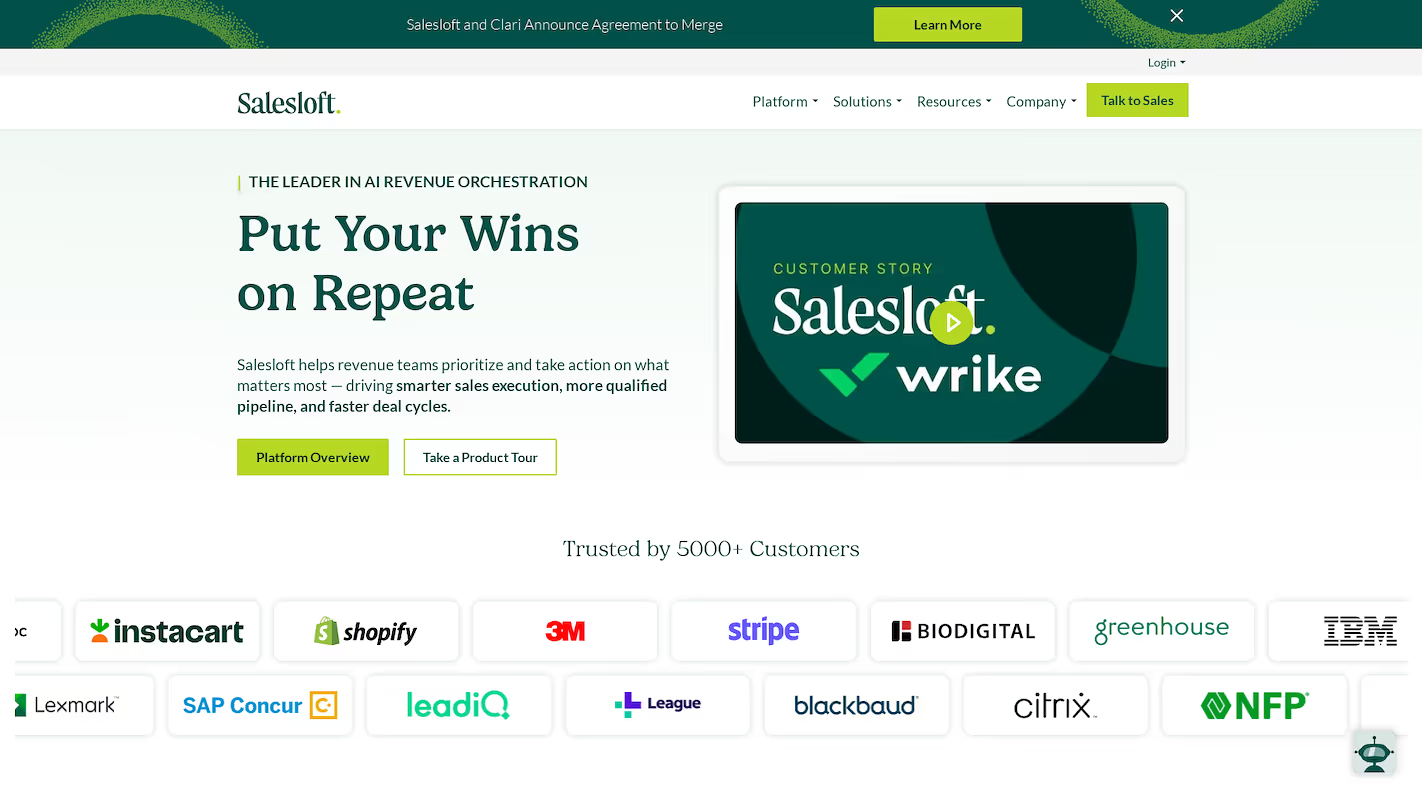
Salesloft is a Revenue Orchestration Platform. It aligns sales engagement, AI insights, conversation intelligence, and deal management in one workflow. AI agents identify buyer signals, prioritize actions, and automate tasks to help teams build pipeline and shorten deal cycles.
The platform supports team productivity, pipeline creation, and opportunity acceleration. It also assists with customer loyalty and provides data-driven forecasts.
Salesloft's Main Features
- Uses Rhythm, an AI prioritization engine, to recommend the right actions at the right moments.
- Deploys AI chat agents through Drift to engage website visitors with personalized, real-time conversations.
- Automates and optimizes sales processes with Conductor AI, a set of outcome-focused AI agents.
- Identifies coaching opportunities through data-driven analysis to help scale best practices across the team.
How Salesloft Compares to Outplay
Average Review score: 4.5/5 stars based on 4,145 G2 reviews.
- Salesloft provides advanced analytics and sales forecasting, which offers deeper pipeline visibility compared to Outplay's standard reporting.
- It includes Conversation Intelligence for detailed call analysis, a more developed function than the basic call features found in Outplay.
- The platform is built for larger teams with complex sales needs, providing more scalability than Outplay, which is often a fit for smaller teams.
- This tool integrates deal management and forecasting directly, whereas Outplay concentrates more on top-of-funnel engagement activities.
Where Outplay Has an Edge Over Salesloft
- Outplay is generally more affordable, with transparent pricing that simplifies budget planning. Salesloft's custom quotes and higher price point may be a better fit for enterprise-level budgets rather than for smaller teams.
- The platform is often considered more user-friendly, which can lead to quicker team adoption. In contrast, some users find Salesloft's comprehensive feature set introduces a steeper learning curve that requires more training time.
- For teams that need core sequencing functions, Outplay offers a focused toolset without extra complexity. Salesloft's all-in-one approach might be more than necessary for organizations that do not use advanced deal management features.
Pricing and Budget Considerations
Outplay offers a license for around $99 per month, providing transparent and predictable costs. Salesloft uses a custom-quote model and does not publish its pricing, so for exact figures, you should visit Salesloft's official website.
3) Apollo.io
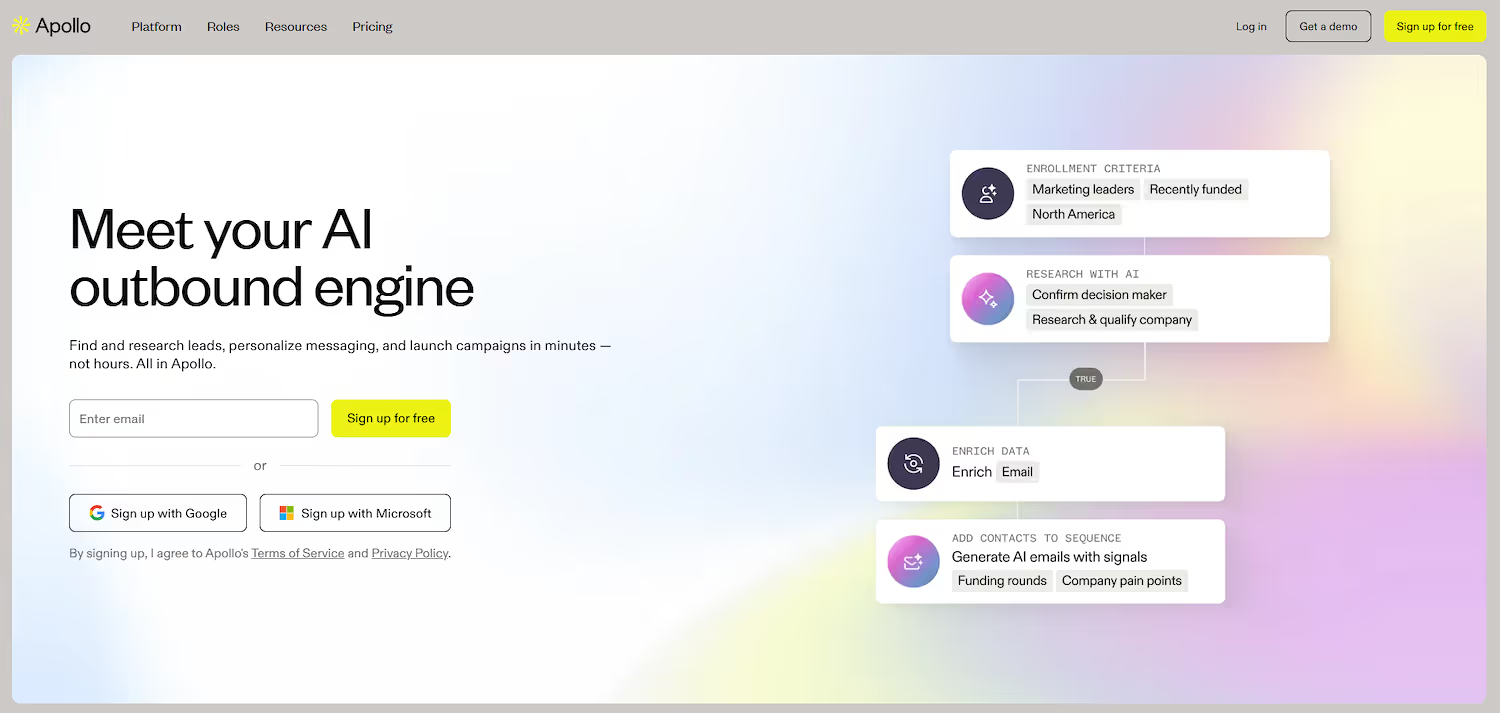
Apollo.io is a sales intelligence and engagement platform. It gives teams access to a large B2B database to find contacts and companies. Users can build prospect lists and score leads to identify potential buyers.
The platform combines data with tools for outreach sequences across email and phone. It also offers analytics to track campaign performance and sales activities, which helps teams manage their go-to-market strategy.
Apollo.io's Main Features
- Accesses a B2B database to find contacts and build prospect lists.
- Scores leads to help identify high-intent buyers within target accounts.
- Integrates its contact database with multi-channel outreach sequences across email and phone.
- Provides analytics to track the performance of sales activities and campaigns.
How Apollo.io Compares to Outplay
Average Review score: 4.7/5 stars based on 8,904 G2 reviews.
- Apollo.io provides a native B2B database with millions of contacts for prospecting. In comparison, Outplay requires users to import their contact lists from other sources.
- It unifies sales intelligence with engagement tools in a single platform. This approach contrasts with Outplay, which centers on outreach execution and often pairs with separate data providers.
- The tool includes a lead scoring function that helps teams identify the most promising prospects. Outplay's features, by comparison, are more focused on tracking engagement activity rather than scoring lead intent.
- A free plan is available on Apollo.io, offering an entry point for individuals or small teams. In contrast, Outplay requires a paid subscription to use its platform.
Where Outplay Has an Edge Over Apollo.io
- Some users find that contact information in Apollo.io can be outdated. This may lead to a higher bounce rate on email campaigns compared to Outplay, which works with a team's own curated contact lists.
- Apollo.io's platform includes data prospecting and engagement, which can be complex for teams that only need outreach functions. Outplay offers a more straightforward experience focused purely on sales sequencing.
- The platform is designed as an all-in-one system, so its CRM sync might feel less central to its workflow. In contrast, Outplay's core design often provides a more seamless integration with a user's primary CRM.
Pricing and Budget Considerations
Apollo.io offers a more accessible pricing model, including a free plan and paid tiers starting at $49 per user per month. This makes it a more budget-friendly choice than Outplay, which is priced around $99 per user per month. For detailed pricing, check Apollo.io's official website.
4) Groove

Groove is a sales engagement platform built for Salesforce users. It helps revenue teams manage workflows and automate tasks like activity capture and calendar sync directly from their inbox. This setup allows teams to work without a constant switch between their email and CRM.
Sales teams use it for multi-channel campaigns. Account managers and customer success teams also use the platform to manage client communication and relationships within their existing Salesforce environment.
Groove's Main Features
- Provides native Salesforce integration that automatically captures and logs all sales activities, emails, and meetings to keep records current.
- Allows teams to access platform features and manage sales workflows directly from their email inbox.
- Supports multi-channel campaigns for outreach through email, calls, and automated follow-ups.
How Groove Compares to Outplay
Average Review score: 4.6/5 stars based on 193 G2 reviews.
- Groove provides a ticketing system to manage customer support issues. This offers more structure for service teams compared to Outplay's focus on sales activity tracking.
- Its shared inbox allows support teams to collaborate on customer responses. This is a more team-oriented approach than Outplay, where email tools are built for individual sales outreach.
- The platform includes a knowledge base for customer self-service. Outplay does not have a similar function, as its toolset centers on direct sales engagement activities.
- Groove's automation converts incoming emails into support cases. This is different from Outplay's automation, which is designed to execute the steps in a sales sequence.
Where Outplay Has an Edge Over Groove
- Groove is built for customer support, so it lacks the dedicated sales sequencing and outreach tools that are central to Outplay. This makes it less effective for prospecting and outbound sales campaigns.
- The platform's automation is designed to create support tickets from emails. In contrast, Outplay automates complex sales outreach across multiple channels, a function not native to Groove's support-focused workflow.
- While Groove has reporting, some users find it is not tailored for sales. Outplay provides more specialized sales analytics, such as detailed campaign performance and lead engagement tracking.
Pricing and Budget Considerations
Groove offers several pricing tiers, starting at $15 per user per month and going up to $40 for its Pro plan. In contrast, Outplay is priced around $99 per user per month, making Groove a more affordable option for teams whose needs align with its support-focused features.
5) Mailshake
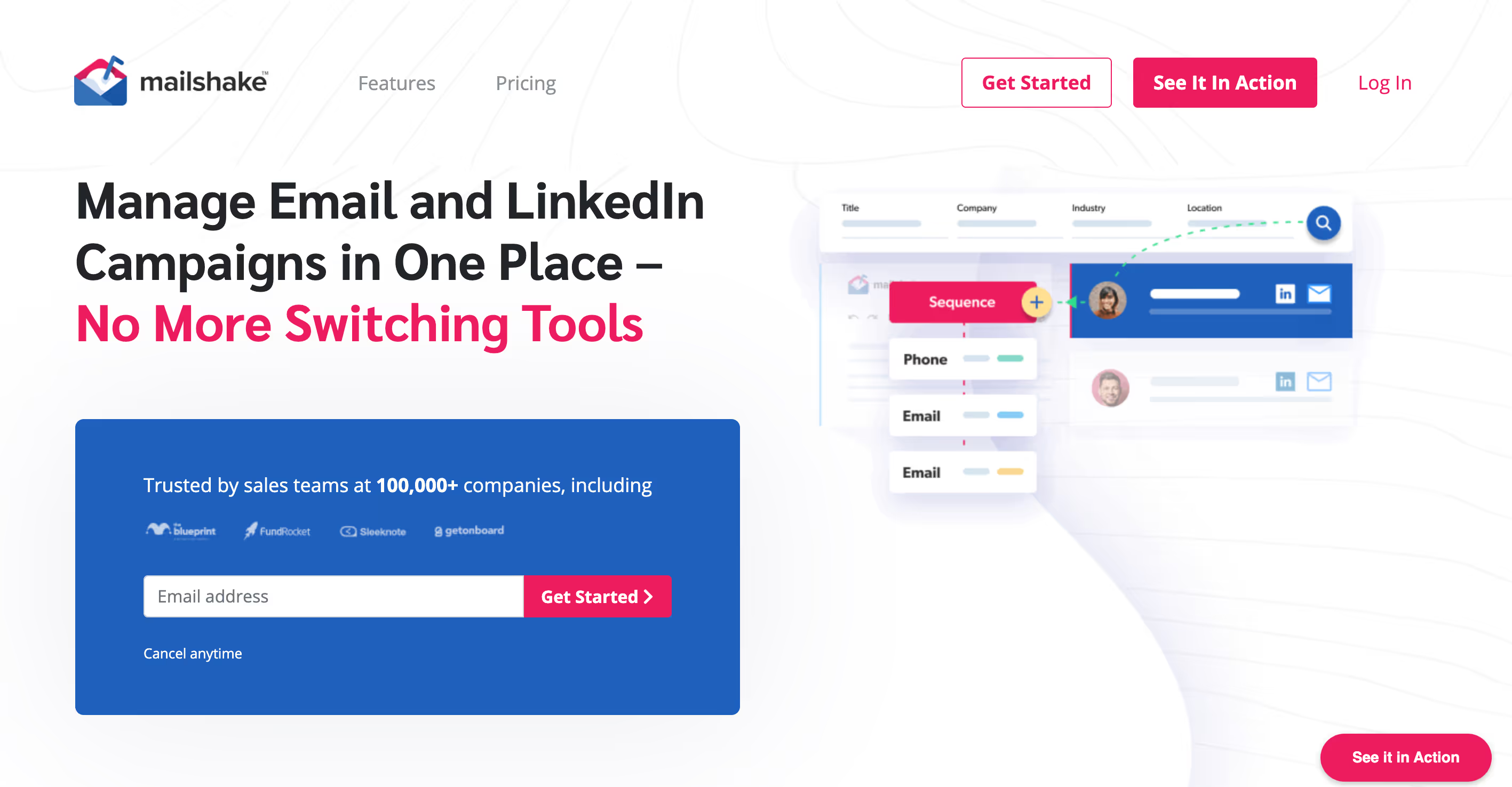
Mailshake is a sales engagement tool designed for cold email outreach. It helps sales professionals automate communication with prospects through personalized sequences. The platform provides analytics on campaign performance and recipient engagement, allowing teams to manage their outreach efforts from a central place.
Mailshake's Main Features
- Uses an AI email writer to generate and vary copy, subject lines, and A/B test variants.
- Includes an email deliverability suite with a domain setup assistant, email warm-up, and list cleaning to help avoid spam folders.
- Provides a built-in data finder to search for and purchase verified prospect email addresses by role, location, or company.
- Automates LinkedIn actions such as connection requests, profile views, and messages as part of a multi-channel sequence.
How Mailshake Compares to Outplay
Average Review score: 4.7/5 stars based on 326 G2 reviews.
- Mailshake provides built-in tools to warm up email accounts and clean lists. This helps improve deliverability, a feature set more developed than Outplay's standard email outreach functions.
- Its AI email writer helps create and A/B test copy. This offers more direct content support compared to Outplay, which centers on sequence execution.
- The platform includes a data finder to search for and acquire verified prospect emails. This contrasts with Outplay, where teams must use their own external contact lists for campaigns.
- It automates LinkedIn tasks, like connection requests and profile views, within a sequence. This provides a social selling component that is more integrated than Outplay's primary email and call focus.
Where Outplay Has an Edge Over Mailshake
- Outplay generally provides a more stable and deep CRM integration. In contrast, some Mailshake users report occasional data sync issues, which might create workflow disruptions for teams that rely heavily on their CRM.
- Mailshake's primary focus is on cold email outreach. Outplay offers a broader sales engagement toolset that includes more robust call-related features, making it a better fit for teams that need a true multi-channel approach.
- The platform is more specialized for email campaigns, which can limit workflow customization. Outplay, by comparison, often allows for more flexibility when building complex sequences that involve a wider variety of sales tasks.
Pricing and Budget Considerations
Mailshake offers several pricing tiers, with its Email Outreach plan at $59 per month and its Sales Engagement plan at $99 per month. This contrasts with Outplay's license, which is priced at around $99 per month. Mailshake's model provides a more budget-friendly entry point for teams that do not require a full sales engagement feature set.
Consider 11x for Digital Sales Workers
If your team wants to use digital workers for sales, 11x provides autonomous agents for outreach and lead qualification. These agents handle specific parts of your sales process. To see how they work, you can book a demo.
At 11x, we use AI agents to manage your sales process. Our agent Alice identifies accounts, enriches data, and runs outreach. Julian qualifies leads and books meetings. We combine data, outreach, and email warmup into one platform, replacing multiple tools in your GTM stack.
Book a demo to see how our agents work.
6) Reply.io
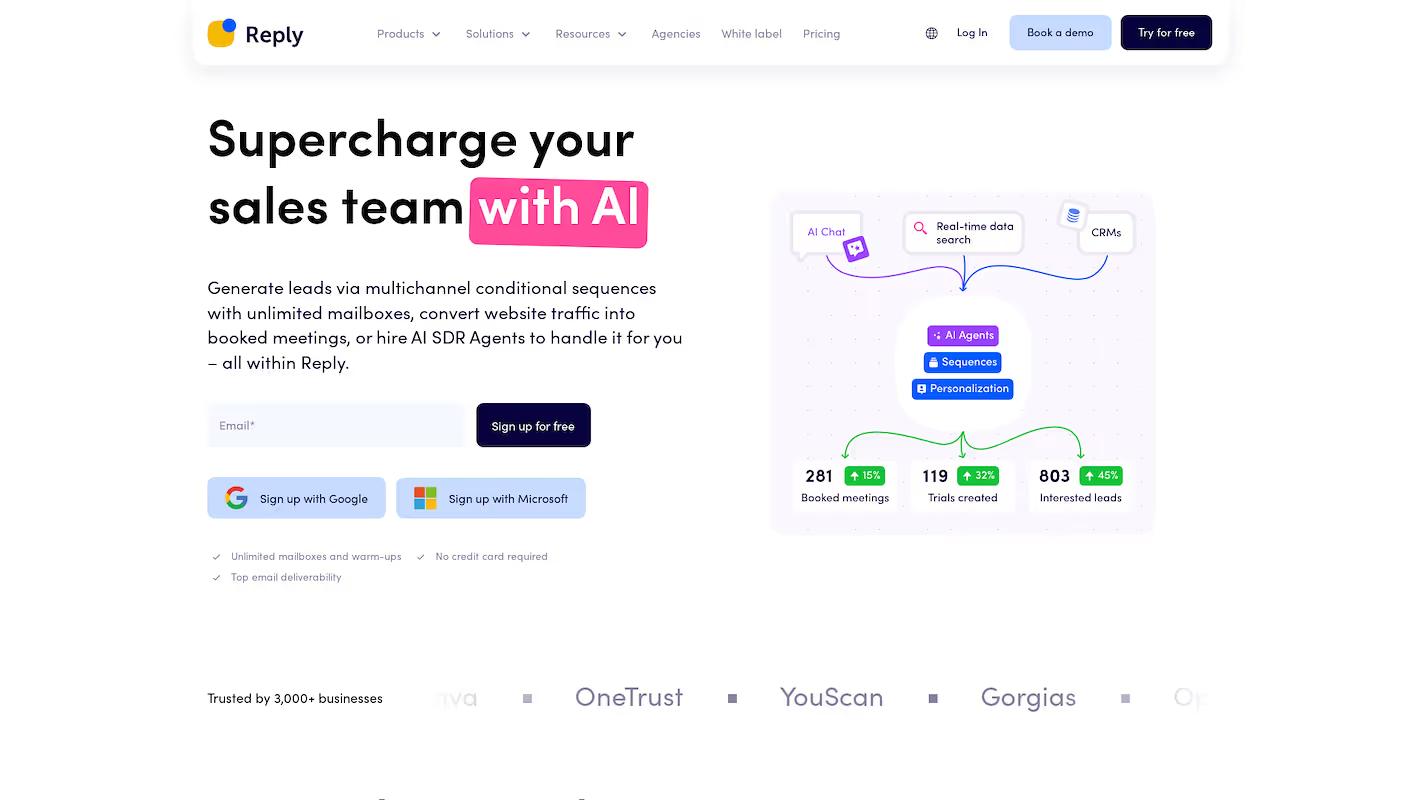
Reply.io is a sales engagement platform for teams to manage the full sales cycle. It helps find prospects with a B2B database and automates outreach across email, LinkedIn, and other channels. The platform uses AI to help create sequences and book appointments for sales and business development.
Reply.io's Main Features
- Deploys an autonomous AI SDR agent to handle prospecting, message generation, reply management, and meeting booking.
- Provides access to a B2B database of over one billion contacts with intent signals and includes monthly live data credits.
- Creates multichannel sequences that combine email, LinkedIn, calls, SMS, and WhatsApp steps.
- Uses AI Variables to generate unique, paragraph-level personalization for emails at scale.
How Reply.io Compares to Outplay
Average Review score: 4.6/5 stars based on 1,458 G2 reviews.
- Reply.io deploys an autonomous AI SDR agent to manage outreach from prospecting to booking meetings. This differs from Outplay, where sales reps typically execute and manage the sequences themselves.
- The platform integrates more outreach channels, such as native WhatsApp and SMS steps. Outplay, in comparison, focuses its multi-channel approach mainly on email and calls.
- It includes an AI chat function to engage website visitors and book meetings. This offers an additional lead capture method not found in Outplay.
- This tool provides a full email deliverability suite, including warm-up services and technical monitoring. This is a more advanced feature set for inbox placement compared to Outplay's standard email functions.
Where Outplay Has an Edge Over Reply.io
- Some users report a learning curve with Reply.io due to its extensive features. In comparison, Outplay is often considered more user-friendly, which can allow for quicker team adoption.
- The platform's CRM integration can sometimes have issues, according to user feedback. Outplay, with its more focused design, often provides a more stable connection to a team's primary CRM.
- Reply.io's all-in-one approach might be complex for teams that only need core outreach. Outplay offers a more direct toolset with robust call features, which can be a better fit for simpler sales workflows.
Pricing and Budget Considerations
Reply.io provides a flexible pricing model, including a free plan and paid tiers starting at $49 per user per month. This offers a more budget-friendly entry point than Outplay's license at around $99 per month, with Reply.io's multichannel plan also being slightly cheaper at $89.
7) Klenty
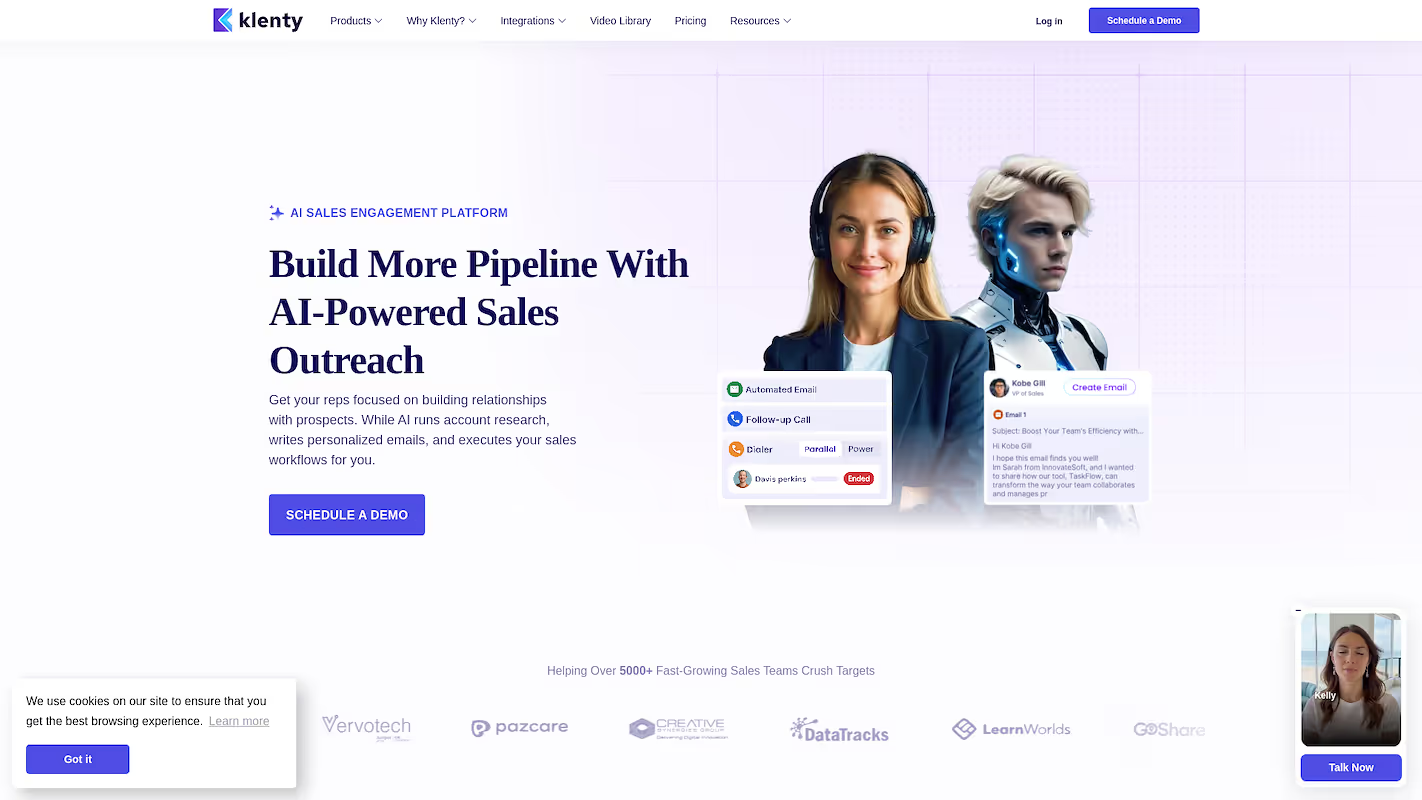
Klenty is a sales engagement platform for sales development and account executive teams. It supports multichannel outreach across email, calls, LinkedIn, and text messages. The platform helps users find prospects, run outreach campaigns, and book meetings. It also integrates with CRMs like Salesforce and HubSpot to sync sales data.
Klenty's Main Features
- Offers a sales dialer with parallel dialing for up to five numbers at once and AI voicemail detection.
- Deploys SchedX, an AI website chat agent, to qualify inbound leads using frameworks like BANT or MEDDIC and book meetings.
- Uses SDRx, an autonomous AI agent, to research accounts, create personalized outreach, and book meetings for outbound prospecting.
- Provides AI Talk-Track Tables for real-time coaching to enforce cold-calling methodology during calls.
How Klenty Compares to Outplay
Average Review score: 4.6/5 stars based on 387 G2 reviews.
- Klenty provides a parallel dialer that calls up to five numbers at once, which can increase a team's call volume compared to Outplay's standard dialer.
- Its AI chat agent, SchedX, qualifies website visitors and books meetings, a feature not available in Outplay for inbound lead management.
- The platform uses an autonomous AI agent, SDRx, for outbound prospect research and personalized outreach. This is different from Outplay, where reps handle these tasks manually.
- This tool includes AI Talk-Track Tables for real-time sales call guidance, offering more direct support than Outplay's post-call analytics.
Where Outplay Has an Edge Over Klenty
- Some users report that Klenty's platform can feel slow at times. Outplay, in comparison, is often praised for its responsive and intuitive interface, which can make daily tasks smoother for sales reps.
- While Klenty connects with CRMs, some user reviews mention occasional data sync issues. Outplay generally offers a more stable CRM integration, which helps ensure that sales activity data remains consistent and reliable.
- Klenty's reporting capabilities might feel limited for teams that require in-depth analysis. In contrast, Outplay provides focused analytics on core engagement metrics, offering a straightforward way to track campaign performance.
Pricing and Budget Considerations
Klenty offers tiered pricing, with plans at $50, $70, and $100 per user per month, providing more budget flexibility than Outplay's single license cost of around $99 per month. While Klenty's Pro plan is priced similarly to Outplay, its lower-tier options offer a more accessible choice for teams with smaller budgets.
8) Mixmax
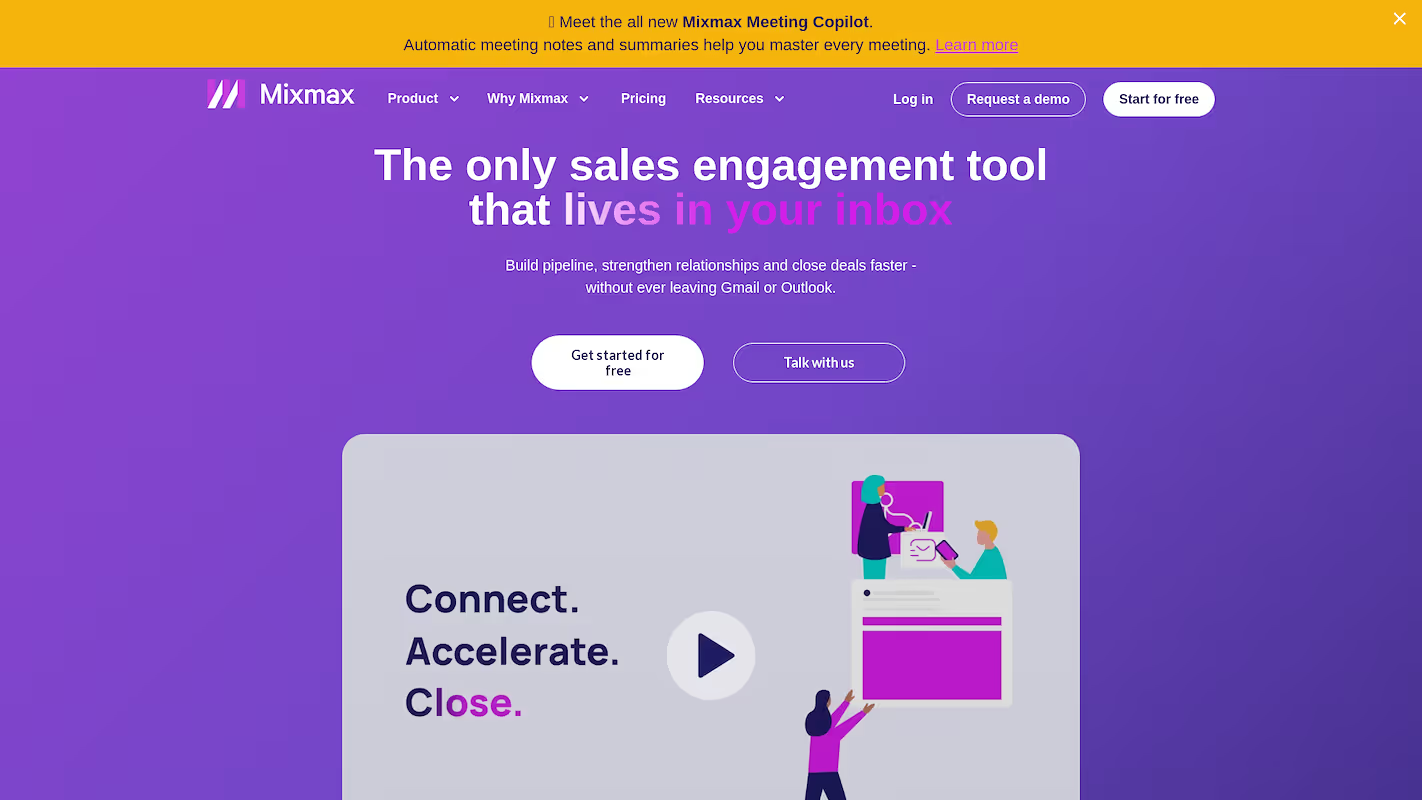
Mixmax is a sales engagement platform that works inside a user's inbox. It helps revenue teams manage daily workflows and buyer communication. The tool supports outreach, helps schedule meetings, and tracks sales activity to provide visibility into the customer lifecycle.
Mixmax's Main Features
- Operates within a user's inbox to manage sales workflows without switching applications.
- Embeds polls and surveys directly into emails to increase recipient engagement.
- Uses AI-powered insights to guide reps on who to contact and which message to send.
- Tracks email open rates, link clicks, and attachment activity for detailed engagement analysis.
How Mixmax Compares to Outplay
Average Review score: 4.6/5 stars based on 1,433 G2 reviews.
- Mixmax operates directly within a user's Gmail inbox, which is different from Outplay where users work from a separate application.
- It allows users to embed polls and surveys directly into emails, providing a way to increase recipient engagement not standard in Outplay.
- The platform's AI provides guidance on who to contact and what message to send, offering more prescriptive advice than Outplay's performance analytics.
- Its integration with the inbox avoids creating a duplicate CRM, which can result in a faster implementation compared to Outplay's setup process.
Where Outplay Has an Edge Over Mixmax
- Outplay provides more advanced calling features as a key part of its multi-channel approach. Mixmax, by comparison, focuses on email-centric workflows, so its native dialer functions are not as comprehensive for teams that rely on phone outreach.
- The platform works as a standalone application, which makes it compatible with any email provider. Mixmax integrates specifically with Gmail, so it is not an option for teams that use Microsoft Outlook or other email clients.
- Some users find that Outplay allows for more complex sequence creation with a wider variety of sales tasks. Mixmax's workflow, centered in the inbox, can sometimes feel restrictive for sequences that go beyond email, polls, and basic scheduling.
- Outplay's architecture often supports a more stable and deep integration with a team's primary CRM. In contrast, some user reviews mention that Mixmax can occasionally have data sync issues, which might affect record accuracy.
Pricing and Budget Considerations
Mixmax provides tiered plans starting at $49 per user per month, with a Salesforce-specific plan at $69. This model offers a more budget-friendly entry point compared to Outplay's license, which is priced around $99 per month. As a result, Mixmax can be a more cost-effective option for teams that do not require Outplay's full feature set.
9) Yesware
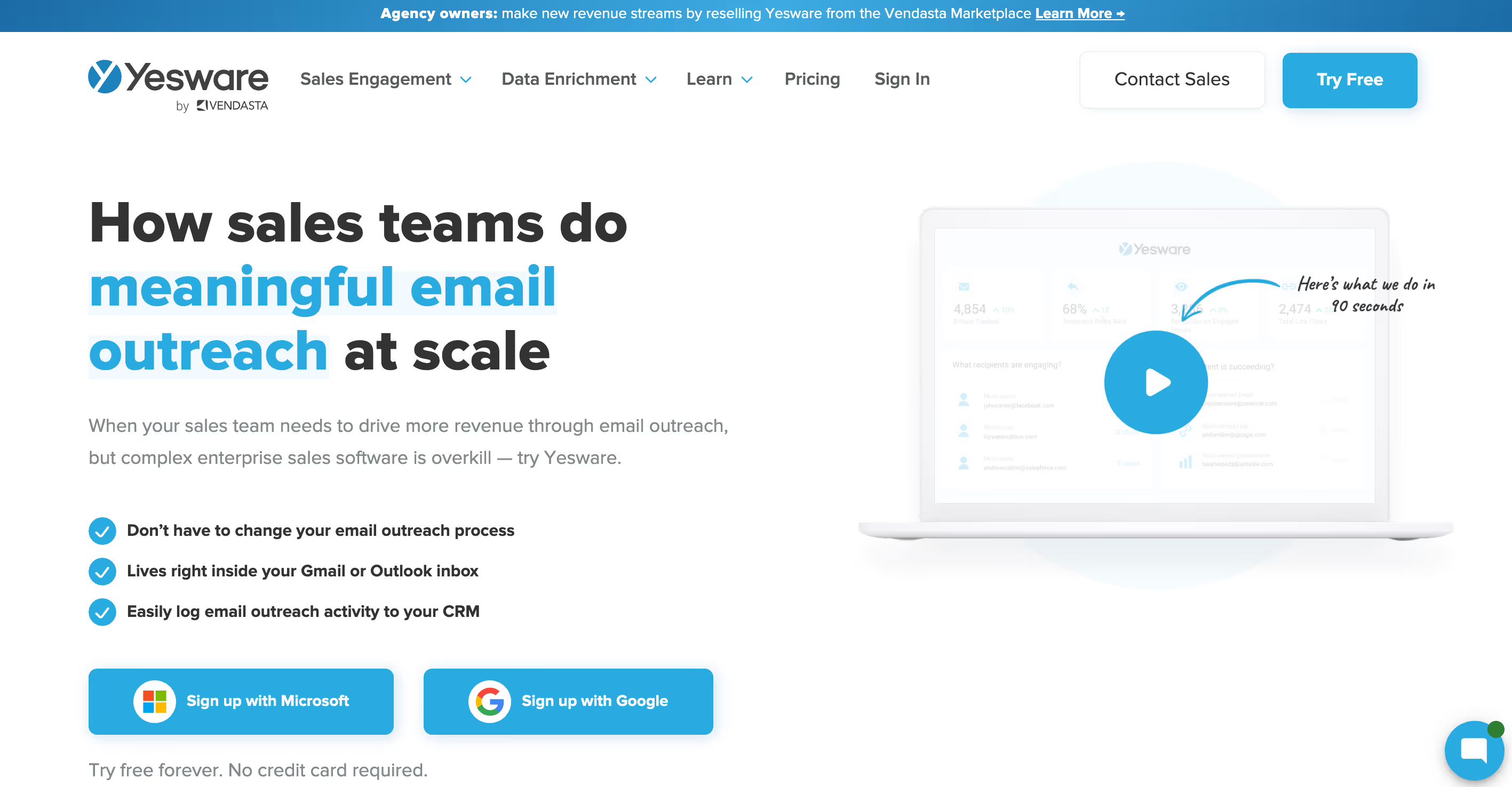
Yesware is a sales toolkit that adds features to a user's inbox. Sales professionals use it to track email activity, apply templates, and automate outreach campaigns. The tool lets teams manage sales communication without a separate application. It provides data on prospect engagement to help reps follow up with interested leads.
Yesware's Main Features
- Integrates with Gmail and Outlook, allowing users to work directly from their inbox.
- Tracks email opens, link clicks, and attachment activity to monitor engagement.
- Manages email content and automates outreach workflows.
- Schedules emails to send at a later time and manages related sales tasks.
How Yesware Compares to Outplay
Average Review score: 4.4/5 stars based on 819 G2 reviews.
- Yesware integrates directly into Gmail and Outlook inboxes. This is different from Outplay, which operates as a separate application and requires users to switch between their inbox and the platform.
- It works within the user's existing email client. This can lead to a simpler setup process compared to Outplay, which is a standalone platform that may need more configuration.
- The tool supports both Gmail and Outlook, offering flexibility for teams on either platform. This provides a more native inbox experience compared to Outplay, which functions as a separate application.
- Yesware provides core email tracking and automation features inside the inbox. This focused approach is different from Outplay's broader, multi-channel toolset that includes more extensive calling features.
Where Outplay Has an Edge Over Yesware
- Outplay provides more robust multi-channel features, particularly for calling. Yesware focuses on email-centric workflows, so its native dialer functions are less comprehensive for teams that rely on phone outreach.
- The tool is limited to Gmail and Outlook because it works as an inbox add-on. In contrast, Outplay is a standalone application, which makes it compatible with any email provider.
- Yesware's focus on inbox integration can feel restrictive for complex sales plays. Outplay often allows for more varied sequences that include a wider range of sales tasks beyond email and scheduling.
- Some users report that Yesware can have occasional technical glitches. Outplay, with its standalone architecture, is often seen as providing a more stable experience for managing sales activities without disruptions.
Pricing and Budget Considerations
Yesware offers tiered pricing, with plans at $15, $35, and $65 per user per month. This makes it a more budget-friendly option compared to Outplay's license, which is priced around $99 per month. For teams that need a cost-effective solution for inbox-centric sales tasks, Yesware provides a more accessible entry point.
10) HubSpot Sales Hub
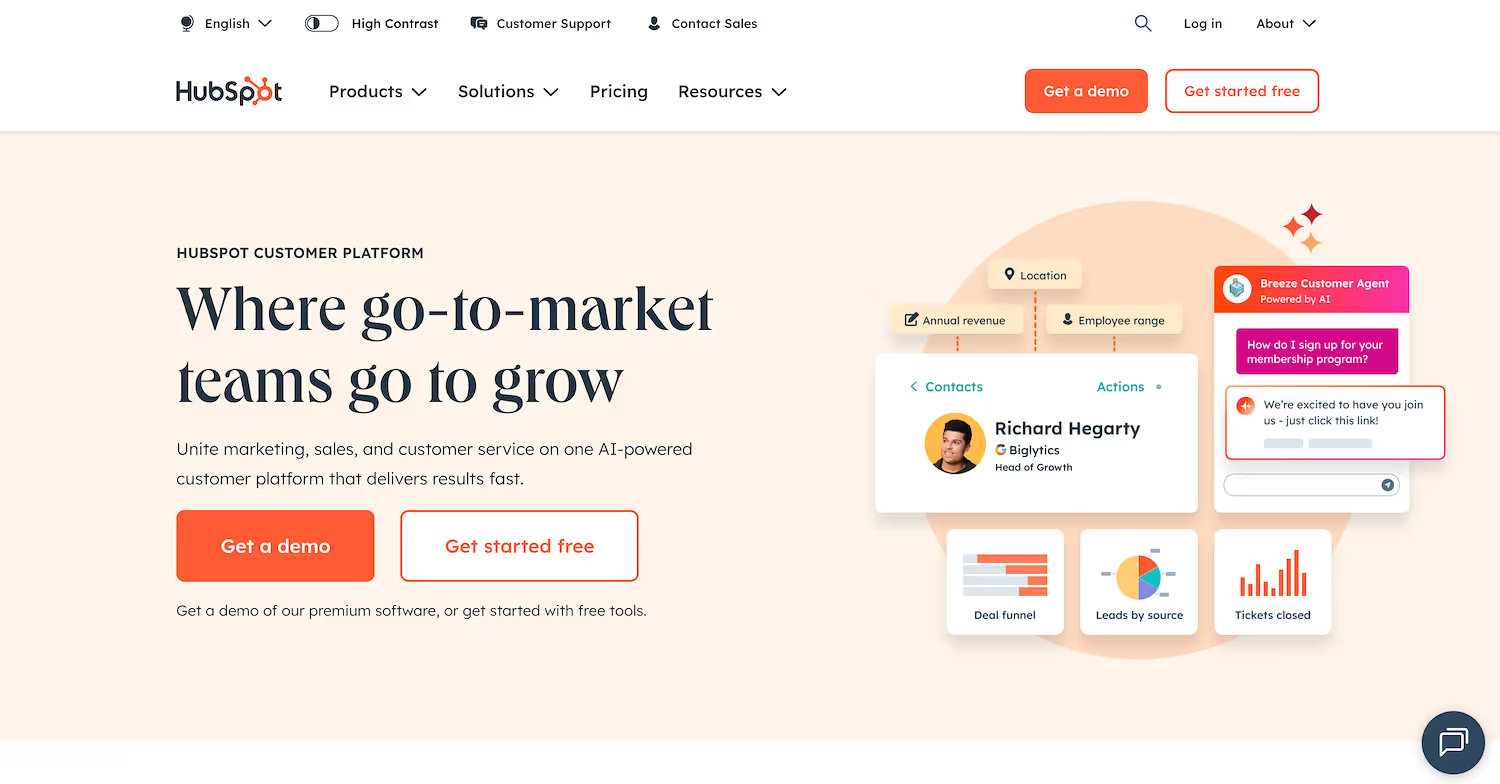
HubSpot Sales Hub is a sales software platform built on the HubSpot CRM. It provides tools for sales engagement, deal management, and analytics. Teams use the platform to manage their pipeline and customer connections from a single place.
The system supports sales reps and leaders with sales automation and reporting functions to help them connect with prospects and close deals.
HubSpot Sales Hub's Main Features
- Manages the sales pipeline with tools for contact, account, and opportunity management.
- Offers marketing automation for email marketing and campaign management.
- Includes customer support functions with case management to handle service inquiries.
- Provides mobile user support and social collaboration features.
How HubSpot Sales Hub Compares to Outplay
Average Review score: 4.4/5 stars based on 12,407 G2 reviews.
- HubSpot Sales Hub is built on its own CRM, which unifies sales, marketing, and service tools. This is different from Outplay, which is a separate application that connects to an existing CRM.
- It includes marketing automation features for creating and managing email campaigns. This provides a broader scope than Outplay, which focuses on sales outreach sequences.
- The platform has customer support functions, including case management for service tickets. Outplay does not offer a comparable feature, as its tools are designed for sales engagement.
- HubSpot provides mobile user support, which allows teams to manage sales activities on the go. This offers more flexibility compared to Outplay's more desktop-focused experience.
Where Outplay Has an Edge Over HubSpot Sales Hub
- HubSpot Sales Hub is an all-in-one system with marketing and service tools, which can be complex for teams that only need outreach. Outplay provides a more focused toolset specifically for sales engagement, which simplifies the workflow for sales-only tasks.
- The tool's features are often locked in higher-priced tiers, which can increase costs for teams that need advanced sales functions. In comparison, Outplay provides its features under a single pricing plan, which makes budgeting more predictable.
- Outplay provides more specialized outbound sales features, like advanced calling functions. Some users report HubSpot's sales tools are less tailored for high-volume outreach compared to a dedicated tool.
Pricing and Budget Considerations
HubSpot Sales Hub offers a tiered model with a free CRM and a Starter plan at $20 per month, providing a more accessible entry point than Outplay. Its Professional plan costs $100 per month, which is comparable to Outplay's license at around $99 per month. However, advanced HubSpot features are in higher-priced tiers, while Outplay offers its toolset in one plan.
Which One Should You Go With?
Choosing the right Outplay alternative depends on many factors, including your team's size, budget, and specific sales process. This guide reviewed several top options to provide a clear basis for your decision.
If you are considering a different approach to sales automation, 11x offers autonomous agents that manage parts of your sales process. These digital workers can handle tasks like outreach and lead qualification, unifying multiple functions into a single platform.




